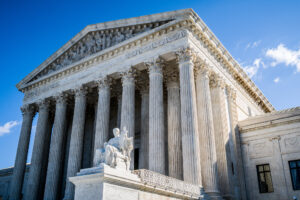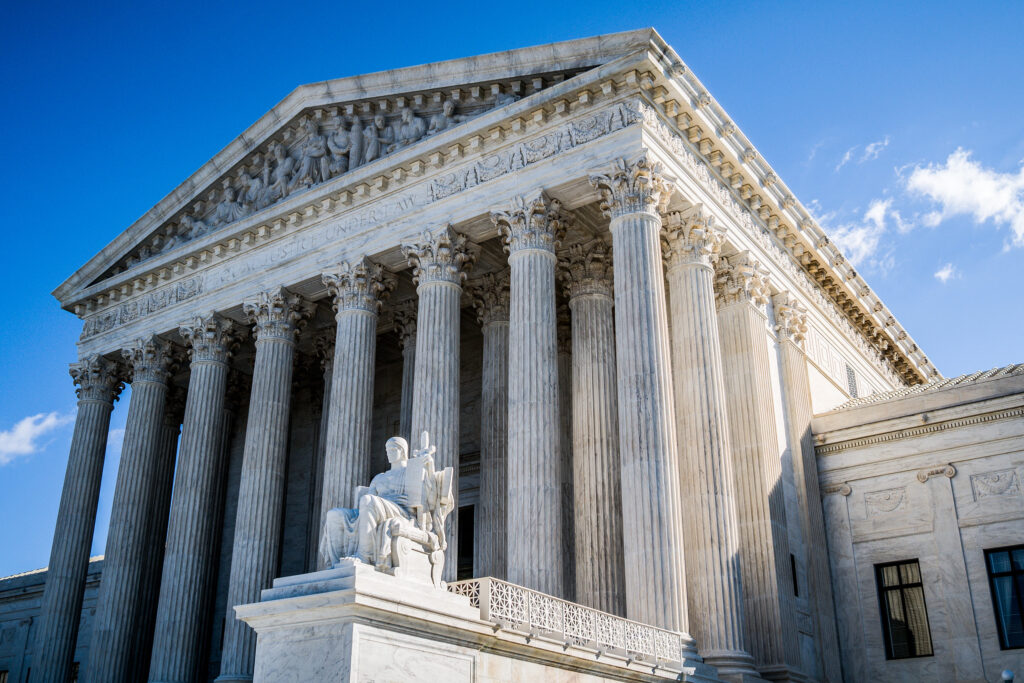By Jonathon Beatty
What happens when a public-school employee’s free speech and free exercise rights run contrary to the Establishment Clause of the First Amendment?[1] The Supreme Court will answer that question in Kennedy v. Bremerton School District[2] and shed light on the intersection of the Free Speech, Free Exercise, and Establishment Clauses.[3] Specifically, the Court granted certiorari on two questions: (1) “[w]hether a public-school employee who says a brief, quiet prayer by himself while at school and visible to students is engaged in government speech that lacks any First Amendment protection”; and (2) “whether, assuming that such religious expression is private and protected by the free speech and free exercise clauses, the establishment clause nevertheless compels public schools to prohibit it.”[4]
Bremerton School District (“BSD”) employed Kennedy as a football coach.[5] A practicing Christian, he felt an obligation to “give thanks through prayer, at the end of each game.”[6] He would kneel on the 50-yard line, where spectators could observe, and say a prayer alone.[7] Over time, students began to join him, eventually growing to “include the majority of the team.”[8] Although he never explicitly or implicitly required participation, BSD ordered Kennedy to stop for fear that, as a government employee, he was violating the Establishment Clause,[9] which requires government neutrality toward religion.[10] This culminated in a recommendation against his rehiring due to his “fail[ure] to follow district policy.”[11]
Subsequently, Kennedy filed suit, arguing that BSD had violated his free speech and free exercise rights.[12] The district court rejected his claims, holding that “BSD’s actions were justified due to the risk of an Establishment Clause violation.”[13] The Ninth Circuit affirmed, agreeing “that BSD would have violated the Establishment Clause by allowing Kennedy to pray at the conclusion of football games, in the center of the field, with students who felt pressured to join him.”[14]
The free speech right of public employees is a complex legal issue. As many questions in the law do, it requires striking a balance, this time between the right of the employee to be free from government censorship and the right of the government to ensure its employees act consistent with their duties, including constitutional requirements. The Supreme Court has made clear, for example, that “[t]he problem . . . is to arrive at a balance between the interests of the teacher, as a citizen, in commenting upon matters of public concern and the interest of the State, as an employer, in promoting the efficiency of the public services it performs through its employees.”[15] Put differently, their employment necessarily curtails their First Amendment rights in order for them to do their job correctly. It involves, like many aspects of life, a tradeoff. But striking the right balance is a difficult task.
Start with the free speech rights of public employees. It is settled law that “a State cannot condition public employment on a basis that infringes the employee’s constitutionally protected interest in freedom of expression.”[16] State employees have free speech rights, and the use of those rights may not form the basis for which he or she is terminated or otherwise denied employment.[17] In Pickering v. Board of Education,[18] for example, the Court held unconstitutional the termination of a teacher who overtly criticized the school board for its allocation of funding.[19] The basis for the teacher’s dismissal ran afoul of democratic norms epitomizing self-government for which “free and open debate is vital.”[20] Teachers do not forfeit their rights “at the schoolhouse gate.”[21]
The extent of an employee’s “interest in freedom of expression,” however, is far from absolute and depends on the context in which the right was exercised. In Garcetti v. Ceballos, for instance, the Court held that “when public employees make statements pursuant to their official duties, the employees are not speaking as citizens for First Amendment purposes, and the Constitution does not insulate their communications from employer discipline.”[22] As any private employer could, a government employer can mandate or prohibit certain expression within reason.[23]
The idea is that the required or forbidden expression is the product of the employment, not of the employee’s private life and thus the liberties that attach.[24] As the Court puts it, “It simply reflects the exercise of employer control over what the employer itself has commissioned or created.”[25] The crucial question is whether the public employee is acting as a citizen or in his or her official capacity. If the former, the Court has “unequivocally rejected” the notion “that teachers may constitutionally be compelled to relinquish the First Amendment rights they would otherwise enjoy as citizens.”[26] And if the latter, employers of all kinds may control the speech of “an employee in his or her professional capacity,” because “[o]fficial communications have official consequences” that impact “the employer’s mission.”[27]
Moreover, the free exercise rights of public employees are equally complex and involve a similar tradeoff between citizen liberty and employer interest. This time, however, the conflict lies directly in the First Amendment, which prohibits the government’s “respecting an establishment of religion” while simultaneously guaranteeing to citizens “the free exercise thereof.”[28] The question is at which point a government employee’s “free exercise” constitutes the government’s “respecting an establishment of religion.”
The Court has held “that a law that is neutral and of general applicability need not be justified by a compelling governmental interest even if the law has the incidental effect of burdening a particular religious practice.”[29] Religion may not excuse citizens from complying with a neutral law that applies generally to everyone.[30] Otherwise, “professed doctrines of religious belief [would become] superior to the law of the land . . . and . . . permit every citizen to become a law unto himself.”[31] The Free Exercise Clause, therefore, applies to a non-neutral law that targets expression because it is religious, not simply because the expression falls within the law’s purview.[32]
Even when the government targets religious expression because it is religious, a Free Exercise claim does not necessarily prevail. The Court has held that “a state interest in avoiding an Establishment Clause violation ‘may be characterized as compelling,’ and therefore may justify content-based discrimination.”[33] As BSD argued in Kennedy, allowing Kennedy’s prayers to continue as is would constitute government action sufficient to violate the Establishment Clause and thus justify the prohibition on Kennedy’s conduct.[34] Nonetheless, the Court has underscored on numerous occasions that the mere presence of religious conduct on public-school property is not under all circumstances sufficient to violate the Establishment Clause.[35]
Therefore, the stage is set for the Court. It will decide (1) whether the speech falls within Kennedy’s “professional capacity” and thus lacks First Amendment protection; and (2) whether, assuming it does not, BSD nevertheless has satisfied strict scrutiny in avoiding an Establishment Clause violation by means “narrowly tailored to advance that [compelling] interest.”[36] Perhaps Kennedy was acting as a citizen. And if he was, perhaps this is one of those circumstances where there was no state action sufficient to constitute an Establishment Clause violation. The Court will soon settle the issue.
[1] U.S. Const. amend. I (“Congress shall make no law respecting an establishment of religion, or prohibiting the free exercise thereof; or abridging the freedom of speech . . . .”).
[2] Kennedy v. Bremerton Sch. Dist., 991 F.3d 1004 (9th Cir. 2021), cert. granted, 142 S. Ct. 857 (2022).
[3] U.S. Const. amend. I.
[4] Kennedy v. Bremerton School District, SCOTUSblog, https://www.scotusblog.com/case-files/cases/kennedy-v-bremerton-school-district-2/ (last visited Feb. 22, 2022); Kennedy v. Bremerton Sch. Dist., 142 S. Ct. 857 (2022) (granting certiorari).
[5] Kennedy, 991 F.3d at 1010.
[6] Id.
[7] Id.
[8] Id.
[9] Id. at 1011.
[10] Good News Club v. Milford Cent. Sch., 533 U.S. 98, 114 (2001) (“[W]e have held that ‘a significant factor in upholding governmental programs in the face of Establishment Clause attack is their neutrality towards religion.’” (quoting Rosenberger v. Rector & Visitors of the Univ. of Va., 515 U.S. 819, 839 (1995))) (alteration in original).
[11] Kennedy, 991 F.3d at 1014.
[12] Id.
[13] Id.
[14] Id. at 1022–23.
[15] Pickering v. Bd. of Educ., 391 U.S. 563, 568 (1968).
[16] Garcetti v. Ceballos, 547 U.S. 410, 413 (2006) (quoting Connick v. Myers, 461 U.S. 138, 142 (1983)).
[17] Id.
[18] 391 U.S. 563.
[19] Id. at 566–67.
[20] Pickering, 391 U.S. at 571–72; see Garrison v. Louisiana, 379 U.S. 64, 74–75 (1964) (“For speech concerning public affairs is more than self-expression; it is the essence of self-government.”).
[21] Tinker v. Des Moines Indep. Cmty. Sch. Dist., 393 U.S. 503, 506 (1969).
[22] Garcetti v. Ceballos, 547 U.S. 410, 421 (2006).
[23] Id. at 418 (“Government employers, like private employers, need a significant degree of control over their employees’ words and actions; without it, there would be little chance for the efficient provision of public services.”).
[24] Id. at 421–22 (“Restricting speech that owes its existence to a public employee’s professional responsibilities does not infringe any liberties the employee might have enjoyed as a private citizen.”).
[25] Id. at 422.
[26] Pickering v. Bd. of Educ., 391 U.S. 563, 568 (1968).
[27] Garcetti, 547 U.S. at 422–23.
[28] U.S. Const. amend. I.
[29] Church of Lukumi Babalu Aye v. City of Hialeah, 508 U.S. 520, 531 (1993) (citing Emp. Div. v. Smith, 494 U.S. 872 (1990)).
[30] See Smith, 494 U.S at 878–79 (“We have never held that an individual’s religious beliefs excuse him from compliance with an otherwise valid law prohibiting conduct the State is free to regulate.”).
[31] Id. at 879 (quoting Reynolds v. United States, 98 U.S. 145, 166–67 (1879)).
[32] Church of Lukumi Babalu Aye, 508 U.S. at 532 (“[T]he protections of the Free Exercise Clause pertain if the law at issue . . . regulates . . . conduct because it is undertaken for religious reasons.”).
[33] Good News Club v. Milford Cent. Sch., 533 U.S. 98, 112–13 (2001) (quoting Widmar v. Vincent, 454 U.S. 263, 271 (1981)).
[34] Kennedy v. Bremerton Sch. Dist., 991 F.3d 1004, 1009 (2021).
[35] See Good News Club, 533 U.S. at 115 (“[W]e have never extended our Establishment Clause jurisprudence to foreclose private religious conduct during nonschool hours merely because it takes place on school premises . . . .”).
[36] Church of Lukumi Babalu Aye, 508 U.S. at 531–32.
Post image by Phil Roeder on Flickr




